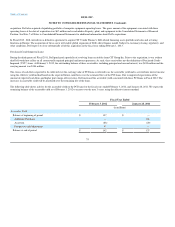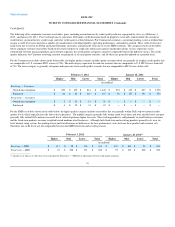Dell 2011 Annual Report Download - page 70
Download and view the complete annual report
Please find page 70 of the 2011 Dell annual report below. You can navigate through the pages in the report by either clicking on the pages listed below, or by using the keyword search tool below to find specific information within the annual report.
Table of Contents DELL INC.
NOTES TO CONSOLIDATED FINANCIAL STATEMENTS (Continued)
recognized over the term of the agreement.
In September 2009, the FASB issued revised guidance, which excluded sales of tangible products that contain essential software elements from the scope of
software revenue recognition guidance. Accordingly, beginning in the first quarter of Fiscal 2011, certain Dell storage products were removed from the scope
of software revenue recognition guidance. Prior to the new guidance, Dell established fair value for PCS for these products based on VSOE and used the
residual method to allocate revenue to the delivered elements. Under the revised guidance, the revenue for what was previously deemed PCS is now
considered part of a multiple deliverable arrangement. As such, any discount is allocated to all elements based on the relative selling price of both delivered
and undelivered elements. The impact of applying this new guidance was not material to Dell's Consolidated Financial Statements for Fiscal 2011 or 2010.
Multiple Deliverables
Dell's multiple deliverable arrangements generally include hardware products that are sold with essential software or services such as extended warranty,
installation, maintenance, and other services contracts. Dell's service contracts may include a combination of services arrangements, including deployment,
asset recovery, recycling, IT outsourcing, consulting, applications development, applications maintenance, and business process services. The nature and
terms of these multiple deliverable arrangements will vary based on the customized needs of Dell's customers. Each of these deliverables in an arrangement
typically represents a separate unit of accounting.
In the first quarter of Fiscal 2011, based on new guidance, Dell began allocating revenue to all deliverables in a multiple-element arrangement based on the
relative selling price of that deliverable. The hierarchy to be used to determine the selling price of a deliverable is: (1) VSOE, (2) third-party evidence of
selling price (“TPE”), and (3) best estimate of the selling price (“ESP”). A majority of Dell product and service offerings are sold on a stand-alone basis.
Because selling price is generally available based on stand-alone sales, Dell has limited application of TPE, as determined by comparison of pricing for
products and services to the pricing of similar products and services as offered by Dell or its competitors in stand-alone sales to similarly situated customers.
As new products are introduced in future periods, Dell may be required to use TPE or ESP, depending on the specific facts at the time.
For Fiscal 2010, pursuant to the previous guidance for Revenue Arrangements with Multiple Deliverables , Dell allocated revenue from multiple element
arrangements to the elements based on the relative fair value of each element, which was generally based on the relative sales price of each element when sold
separately. The adoption of the new guidance in the first quarter of Fiscal 2011 did not change the manner in which Dell accounts for its multiple deliverable
arrangements as Dell did not use the residual method for the majority of its offerings and its services offerings are generally sold on a stand-alone basis where
evidence of selling price is available.
Other
Dell records revenue from the sale of equipment under sales-type leases as product revenue in an amount equal to the present value of minimum lease
payments at the inception of the lease. Sales-type leases also produce financing income, which is included in net revenue in the Consolidated Statements of
Income and is recognized at consistent rates of return over the lease term. Dell also offers qualified customers revolving credit lines for the purchase of
products and services offered by Dell. Financing income attributable to these revolving loans is recognized in net revenue on an accrual basis.
Dell reports revenue net of any revenue-based taxes assessed by governmental authorities that are imposed on and concurrent with specific revenue-producing
transactions.
Standard Warranty Liabilities — Dell records warranty liabilities for its standard limited warranty at the time of sale for the estimated costs that may be
incurred under its limited warranty. The liability for standard warranties is included in accrued and other current and other non-current liabilities on the
Consolidated Statements of Financial Position. The specific warranty terms and conditions vary depending upon the product sold and the country in which
Dell does business, but generally includes technical support, parts, and labor over a period ranging from one to three years. Fa ctors that affect Dell's warranty
liability include the number of installed units currently under warranty, historical and anticipated rates of warranty claims on those units, and cost per claim to
satisfy Dell's warranty obligation. The anticipated rate of warranty claims is the primary factor impacting the estimated warranty obligation. The other factors
are less significant due to the fact that the average remaining aggregate warranty period of the covered installed base is approximately 15 months, repair parts
are generally already in stock or available at pre-determined prices, and labor rates are generally arranged at pre-established amounts with service providers.
67
























